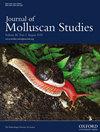The polymorphic top-shell puzzle: iterative taxonomy of Calliostoma Swainson, 1840 (Gastropoda: Calliostomatidae), in the Mediterranean Sea
IF 1.2
4区 生物学
Q2 MARINE & FRESHWATER BIOLOGY
引用次数: 0
Abstract
Calliostoma Swainson, 1840, as currently conceived, is the most species-rich genus of the order Trochida, with over 350 recognized species worldwide. The shell variability in these vetigastropods is extremely high, resulting in conflicting taxonomic attributions at both the genus and species levels. In the Mediterranean Sea, the remarkable morphological diversity of the Calliostoma top shells has led to the description of dozens of different taxa, of which nine are currently accepted. This taxonomic framework was tested using an iterative taxonomic approach. Species delimitation (using assemble species by automatic partitioning, clade monophyly and Kimura-2-parameter distances) and phylogenetic analyses (maximum likelihood and Bayesian inference) were carried out on 247 specimens from the Mediterranean and neighbouring Atlantic, including eight Mediterranean species and the Azorean C. lividum, spanning a large part of the morphological diversity and geographic distribution of the genus in the area. The molecular dataset comprised one nuclear marker, internal transcribed spacer 2 (ITS 2), and two mitochondrial markers (cytochrome c oxidase subunit 1 and 16S ribosomal RNA). Results indicate that the number of species is overestimated, as only C. conulus, C. granulatum, C. zizyphinum and C. laugieri are supported by molecular data among the assessed species. It is suggested that the morphological characters commonly used to diagnose species are variable within a single taxon, as three nominal taxa, allegedly endemic to the Mediterranean Sea, are here shown to be a single genetic species (C. laugieri). An ITS 2 2D folding structure is also reported as potentially distinctive for calliostomatids, compared to known Vetigastropoda. Our study indicates that to address the taxonomy of calliostomatid top shells, an integrative approach including molecular data is highly advisable to support species delimitation and especially new species description.多态顶壳之谜:地中海 Calliostoma Swainson, 1840(腹足纲:Calliostomatidae)的迭代分类学
目前认为,Calliostoma Swainson, 1840 是蛙形目中物种最丰富的属,在全世界有 350 多个公认的物种。这些软体动物的外壳变异性极高,导致在属和种的分类归属上相互矛盾。在地中海,Calliostoma 顶壳具有显著的形态多样性,因此被描述为数十个不同的类群,其中 9 个类群目前已被接受。该分类框架采用迭代分类法进行测试。对来自地中海和邻近大西洋的 247 个标本进行了物种划分(通过自动分区、支系单系化和木村-2 参数距离来组合物种)和系统发生分析(最大似然法和贝叶斯推断法),其中包括 8 个地中海物种和亚速尔群岛的 C. lividum,涵盖了该属在该地区的大部分形态多样性和地理分布。分子数据集包括一个核标记(内部转录间隔 2 (ITS 2))和两个线粒体标记(细胞色素 c 氧化酶亚单位 1 和 16S 核糖体 RNA)。结果表明,物种数量被高估了,因为在评估的物种中,只有 C. conulus、C. granulatum、C. zizyphinum 和 C. laugieri 得到了分子数据的支持。这表明,通常用于诊断物种的形态特征在单个类群内是可变的,因为三个据称是地中海特有的标称类群在这里被证明是单个遗传物种(C. laugieri)。据报道,与已知的腹足纲动物相比,胼胝体动物的 ITS 2 2D 折叠结构可能具有独特性。我们的研究表明,要解决胼胝体顶贝类的分类问题,最好采用包括分子数据在内的综合方法来支持物种划分,尤其是新物种的描述。
本文章由计算机程序翻译,如有差异,请以英文原文为准。
求助全文
约1分钟内获得全文
求助全文
来源期刊

Journal of Molluscan Studies
生物-动物学
CiteScore
3.00
自引率
8.30%
发文量
36
审稿时长
3 months
期刊介绍:
The Journal of Molluscan Studies accepts papers on all aspects of the study of molluscs. These include systematics, molecular genetics, palaeontology, ecology, evolution, and physiology. Where the topic is in a specialized field (e.g. parasitology, neurobiology, biochemistry, molecular biology), submissions will still be accepted as long as the mollusc is the principal focus of the study, and not incidental or simply a convenient experimental animal. Papers with a focus on fisheries biology, aquaculture, and control of molluscan pests will be accepted only if they include significant advances in molluscan biology. While systematic papers are encouraged, descriptions of single new taxa will only be considered if they include some ‘added value’, for example in the form of new information on anatomy or distribution, or if they are presented in the context of a systematic revision or phylogenetic analysis of the group.
 求助内容:
求助内容: 应助结果提醒方式:
应助结果提醒方式:


